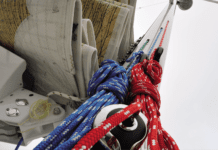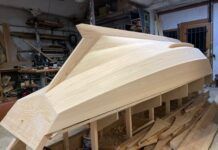A few years ago while sailing my PDQ catamaran, we struck something hard and bent the rudder so badly that the top of the trailing edge jammed against the hull. Fortunately, we could disconnect the rod linking the two rudders, and get home with just one rudder.
While often the rudder and stock are usually removed for straightening, I’d heard tales of simply pulling them back in situ. Certainly, the rudder tube and bearings must be strong enough to bend the rudder without creating a hole in the boat, but it was clear the construction had a considerable safety factor.
A few back-of-the envelope engineering calculations confirmed for me that the straightening load would not be a problem. Certainly the load of careful bending would be gentle compared to the strike that bent it.
Rudder Design
The second bit of required information is the rudder armature design. While it would be lovely if the stock continued to the bottom, this is not required for sailing strains and thinning of the blade often makes it impossible. Instead, the rudder is typically made with a rigid foam core fitted around a stock stub that extends only partially down the rudder, with welded reinforcements extending down and aft.
In order to keep the leverage point as low as possible on the rudder and minimizing force on the bearings and tube, while protecting the rudder trailing edge and armature, I built a virtual cast for the trailing edge to distribute the straightening pressure along the entire rudder. The cast was built from a pair of 2 by 6 planks, one of which was beveled to match the taper of the rudder trailing edge, bolted together with three 5/16-inch carriage bolts, and then notched to retain the pulling cable. A non-stretch belt secured the cast tightly to the upper rudder, the curved profile of the trailing edge, and some flex in the planks combined to provide even support.
For the PDQ 32, calculations determined the stock would straighten with about 1,350 pounds applied low on the rudder. Fortunately, we had a dynamometer to measure loads.
The front of the tackle was attached to doubled ½-inch polyester double braid rope looped around the hull forward of the keel (always use low-stretch lines for pulling under high load—nylon can whip dangerously if it breaks, and application of force is less accurate). This provided a nice low anchor point. The chain fall was a rated at one ton working load. Because of the poor traction on gravel I could only pull it to 1,000 pounds, so I connected a spinnaker sheet to the chain with a sling and used a winch to save my back. (The turning block is anchored to another rope sling, this one wrapped around the transom).
This arrangement makes it easy to increase the pressure in a very controlled manner, while monitoring the bending progress and the applied force. Note that none of the forces were applied from off the boat, which would result in dragging the boat off of its jackstands.
At about 700 pounds the rudder came clear of the hull, and by 1,320 pounds the trailing edge was about 1-inch clear; calculations had predicted 1,350 pounds. We released the tackle, and it sprung back to 1/2-inch clearance, our target clearance.
I then turned the rudder hard over to each side, inspecting for any evidence of cracking around the stock; the bottom paint was still well adhered and spanned the transition from stock to rudder without a crack. Further inspection of the rudder and keel leading edges revealed nothing; I suppose submerged logs must have a little surface softness about them.
We spent a lot of time on preparation, but once the pulling started, everything went smoothly. I was once told by a rigger (the 100-ton crane and millwright type, not sailboats) that moves should always look easy; if there is straining or tugging involved, something is going to break or someone is going to get hurt. It’s all about control.
Not every bent rudder will be so simple to straighten. If the rudder had been bent severely to the side or further back, and driven far into the hull, I would not trust rebending; the rudder could be damaged. With a monohull, having only one rudder, a lot depends on reliable steering. But for minor tweaks, a little pulling can save a pile of boat bucks and weeks or months out of the water.








































